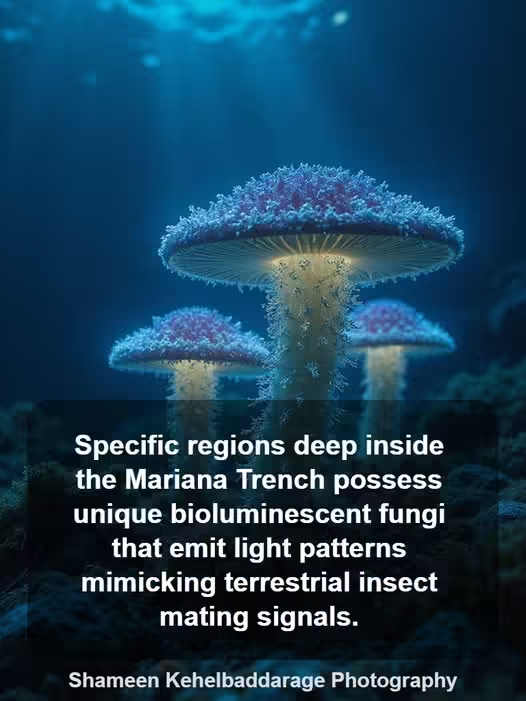
Bioluminescent Mimics of the Deep: The Strange Fungi Lurking in the Mariana Trench
Far beneath the reach of sunlight, in the darkest and most pressurized corners of our planet, life has found astonishing ways to adapt. The Mariana Trench, the deepest known part of the Earth’s oceans, remains one of the most enigmatic places on the planet. With crushing pressures over 1,000 times greater than at sea level and temperatures barely above freezing, it’s a realm few would expect to host complex, visually communicative life. But a stunning new discovery has changed that perception—a strange species of deep-sea fungi that glows with an eerie, intelligent light.
These fungi, newly identified by a team of marine biologists and microbiologists, possess a highly unusual form of bioluminescence—not simply as a glow to ward off predators or attract mates like other deep-sea life, but as a complex, patterned signal system. What’s truly baffling is that these glowing patterns mimic the mating flashes of terrestrial insects—most notably fireflies. This bizarre mimicry, thousands of meters below the ocean surface and utterly disconnected from the forested ecosystems where fireflies evolved, has opened up entirely new questions about convergent evolution, biological signaling, and cross-environmental mimicry.
Evolution in the Abyss
Fungi are among the most ancient and resilient life forms on Earth. We’ve found them thriving in frozen tundras, arid deserts, and nuclear reactors. But the Mariana Trench represents one of the most extreme habitats known—an environment of perpetual darkness, crushing pressure, and isolation. The fungi discovered here were first detected by autonomous deep-sea rovers equipped with low-light imaging systems, designed to track signs of bioluminescence for ecological mapping.
At first, researchers assumed they had encountered standard glowing bacteria or planktonic colonies. But as the patterns of light repeated and pulsed in symmetrical, pulse-coded bursts, it became evident this wasn’t simple phosphorescence—it was communication.
When samples were eventually retrieved and studied in high-pressure labs, the behavior of the fungi only deepened the mystery. Their glowing emissions weren’t constant or random; they fired in a sequence startlingly similar to the mating flashes used by fireflies on land. Insects use these blinking light signals to identify compatible mates of the same species, often with highly specific timing. The fungi’s pulses matched several of these timings almost perfectly—yet they exist in an ecosystem where no fireflies have ever existed.
Why Mimic Something You’ve Never Seen?
That question has fascinated evolutionary scientists. How could organisms in such a remote, alien environment evolve to mirror something so specific, and seemingly irrelevant?
One prevailing theory is that this is a case of evolutionary mimicry driven by utility rather than direct exposure. In other words, the fungi didn’t “copy” fireflies—they independently evolved a similar strategy that coincidentally mimics terrestrial light signaling. This would be a remarkable case of convergent evolution, where two entirely unrelated species in different environments arrive at nearly identical solutions to similar problems—in this case, attracting mobile organisms using coded bioluminescence.
But for what purpose? That’s where things get even more fascinating.
Symbiosis, Predation, or Propulsion?
The Mariana fungi likely don’t glow for beauty or mating—fungi reproduce through spores, not sexual displays. Researchers hypothesize their bioluminescent mimicry serves three possible purposes:
Luring Prey: Some bioluminescent animals attract smaller creatures, which mistake the light for food or other animals. The fungi might use this mimicry to draw in deep-sea plankton or filter feeders, possibly to trap them in sticky filaments or benefit from nutrients released during decay.
Symbiotic Hitchhiking: By mimicking attractive light patterns, the fungi may cause certain deep-sea creatures—like shrimp or small fish—to approach and unknowingly carry fungal spores on their skin or in their gills, transporting them through the water column. In such an isolated environment, dispersal is everything, and these “vehicles” might be critical to spreading the fungi to new surfaces or ecosystems.
Defensive Decoy: Alternatively, the fungi may use the flashes as a false signal, mimicking more dangerous or unpalatable organisms to avoid being consumed. In deep-sea ecosystems, deception is often the best survival strategy.
Whichever theory proves true, it highlights a complex, strategic level of adaptation rarely associated with fungi.
A Living Signal in the Darkness
What makes this discovery so profound isn’t just that it challenges our understanding of how fungi behave—it also blurs the line between simple life and intelligent adaptation. These fungi aren’t mindless organisms growing in the dark; they are actively signaling, using visually sophisticated patterns that serve deliberate biological functions.
And they do so in the deepest dark on Earth, where no sunlight ever reaches.
The implications for astrobiology are especially exciting. If such advanced signaling can evolve in the pitch-black trenches of Earth’s oceans, could similar processes emerge in the subsurface oceans of Europa or the methane lakes of Titan? The Mariana fungi prove that light doesn’t need the sun—and intelligence doesn’t need a brain.
Bioluminescent Codes: A Universal Language?
There’s also the curious notion that light patterns might represent a kind of universal biological language. Just as animals evolved to interpret color and sound in specific ways, perhaps organisms in extreme environments use rhythmic light signals as a form of interspecies communication or warning.
Imagine entire ecosystems “speaking” in flashes and pulses, with different life forms evolving ways to read and interpret these light patterns—an underwater Morse code of survival. The Mariana fungi may be just the first of many organisms to unlock this possibility.
The Deep Sea Still Holds Secrets
This discovery serves as a powerful reminder that Earth is still an unexplored planet in many ways. Despite satellite imagery, deep-sea drilling, and robotic exploration, over 80% of the ocean remains unmapped and unobserved. The deep-sea fungi of the Mariana Trench offer a glimpse of how much we still have to learn—not just about the oceans, but about life itself.
These glowing fungal organisms are not only bizarre and beautiful—they are living clues to the fundamental mechanics of evolution, adaptation, and ecological intelligence.
Final Thoughts: The Glow of Curiosity
In a world saturated with digital distractions and terrestrial familiarity, it’s comforting to know that there are still mysteries buried beneath us—silent, glowing enigmas waiting in the dark. The Mariana fungi are more than a scientific curiosity; they’re a biological metaphor for hope and hidden knowledge. Even in the harshest, most unlikely corners of Earth, life finds a way—not just to survive, but to communicate, to adapt, and to astonish us.
As research continues and new samples are analyzed, we may uncover even more intricate behaviors among these deep-sea mimics. For now, their flashing signals remain an unanswered riddle, blinking quietly in the black.
And maybe, just maybe, they’re not only trying to communicate with the ocean around them—but with us.


